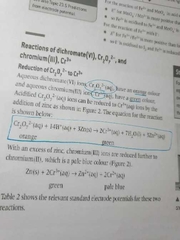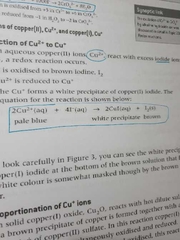![]()
![]()
![]()
Use LEFT and RIGHT arrow keys to navigate between flashcards;
Use UP and DOWN arrow keys to flip the card;
H to show hint;
A reads text to speech;
45 Cards in this Set
- Front
- Back
- 3rd side (hint)
|
What is an oxidising agent |
It is a substance that takes electrons away from the atom that is being oxidised . it contains the atom that is reduced |
|
|
|
What is a reducing agent |
Any truth in aging is a substance that add electrons to the atom that is reduced and it contains the atom that is oxidised |
|
|
|
Manganate réduction équation |
MnO4^- + 8H^+ + 5e- ---> Mn^2+ + 4H2O |
|
|
|
What is acidified manganate |
It is an oxidising agent meaning that it is reduced |
|
|
|
What colour is potassium manganate |
It is purple |
|
|
|
During titration with manganate redox titration what goes in the burette |
The potassium manganate which is a purple colour goes into the burette |
|
|
|
What is the Endpoint of a manganate redox titration |
At the Endpoint the solution changes from colourless to a permanent pink colour. the reaction self indicating |
|
|
|
Oxidation of Iron half equation |
Fe^2+ ----> Fe^3+ + e- |
|
|
|
Why is dilute sulfuric acid added into potassium manganate titration |
To supply the H+ ions |
|
|
|
What is the first stage of an iodine thiosulfate redox reaction |
The oxidizing agent is first reacted with an excess iodine ions. Iodine ions are oxidised to iodine |
|
|
|
What is the second stage of an iodine thiosulfate redox reaction |
The iodine generated is then titrated with thiosulfate ions. Thiosulfate ions are oxidised in iodine is reduced to iodide |
|
|
|
What's the half equation for the oxidation of thiosulfate ions |
2S2O3^2- ---> S4O6^2- + 2e- |
|
|
|
What happens during the sodium thiosulfate reaction? |
1. A standard solution of sodium thiosulfate is added to the burette 2. Excess KI and oxidising agent are added to the conical flask 3. The oxidising agent reacts with iodide ions to form iodine... turning the solution a yellow-brown colour 4. Burette tap is opened, and sodium thiosulfate added 5. As the end point approaches, colour changes from yellow brown to pale straw colour 6. Starch indicator added, forming a deep blue black And at the end point, the colour changes from blue black to colourless, indicating all the iodine has reacted |
|
|
|
What are the main colour changes in a sodium thiosulfate réaction? |
Yellow brown to pale straw. Then to blue black and then to colourless |
|
|
|
What happens when iodine thiosulfate titrations are used to analyse copper ions |

The copper ions are reduced by the iodine to form a white precipitate of copper iodide.
The iodide ions are oxidised to form a yellow brown solution of iodine
Then the iodine is titrated with sodium thiosulfate |
|
|
|
What is the molar ratio of copper to thiosulphate ions |
1:1 |
|
|
|
What is brass an alloy of |
Zinc and copper |
|
|
|
What does a half cell contain |
It contains the chemical species present in a redox half equation |
|
|
|
What is electrode potential |
Electrode potential is the tendency for electrons to be gained and for reduction to take place in a half cell |
|
|
|
What metal is used in a half cell based on ions of the same element in different oxidation states |
Platinum is used since it is unreactive |
|
|
|
What does the electrode do |
The electrode transport electrons into out of the half cell |
|
|
|
What is the standard electrode potential |
It is the electromotive force of a half cell connected to the standard hydrogen half cell under standard conditions |
|
|
|
What is the standard electrode potential of a standard hydrogen electrode |
It is 0 volts |
|
|
|
What makes up a standard hydrogen half cell |

Look at this diagram |
|
|
|
How is standard electrode potential measured |
It is measured through a half cell connected to a standard hydrogen electrode |
|
|
|
What is the purpose of a salt bridge |
It allows ions to flow |
|
|
|
What makes up the salt bridge |
The salt bridge contains the concentrated solution of an electrolyte that does not react with either solution |
|
|
|
What does a more negative electrode potential value mean |
It means that there's a greater tendency to lose electrons and undergo oxidation |
|
|
|
What is the negative electrode |
The negative electrode is the anode and it belongs to the element with the most negative electrode potential |
|
|
|
How do you work out standard cell potential |
More positive - more negative electrode potential |
|
|
|
What is the first limitation of feasibility predictions |
Reaction rate. I Predict a reaction may have a large activation energy resulting in a very slow rate |
|
|
|
What is the second limitation of a feasibility prediction |
Concentration. Predictions are based on standard electrode potentials measured using concentrations of 1moldm^-3. For concentrations that aren't 1moldm^-3 then the electrode potential is different |
|
|
|
Give me a description of a primary cell and an example |
A primary cell is one use only meaning that it can only be used until the chemicals have reacted. This cell is not rechargeable and an example of this would be the Zinc copper cell |
|
|
|
What is a secondary cell |
A secondary cell can be recharged. d During recharging the reaction that discharges the cell is reversed. |
|
|
|
What is a fuel cell |
A fuel cell uses the energy from the reaction of a fuel with oxygen to create a voltage. |
|
|
|
In a fuel cell where is oxygen |
Oxygen is at the positive electrode where reduction place |
|
|
|
Do Fuel Cells need recharging? |
Nope. They function all the time as long as they have a continuous supply of oxygen and fuel |
|
|
|
Colour change for reduction of manganate with Iron |
Purple to colourless |
|
|
|
Colour change for the reduction of Fe²+ |
Orange brown to pale green |
|
|
|
Give the equation for when acidicfied Cr2O7²- are reduced to Cr³+ by addition of zinc |

|
|
|
|
What's the colour change for when acidified dichromate ions are reduced? |
Orange to green |
Cr2O7²- |
|
|
When zinc is in excess what can happen to chromium (III) ions |
They can be reduced further to form chromium (II) ions which is pale blue |
|
|
|
What can hot alkaline H2O2 (hydrogen peroxide) be used? |
Since it's a strong oxidising agent it can be used to oxidise chromium (III) to chromium (VI) in CrO4²- |
|
|
|
What's the overall reaction for the oxidation of chromium (III) |

3H2O2 + 2Cr³+ + 10OH- ---> 2CrO4²- + 8H2O |
|
|
|
What's the equation for when Cu²+ reacts with excess I ions |

|
Pale blue to white precipitate in brown solution |

